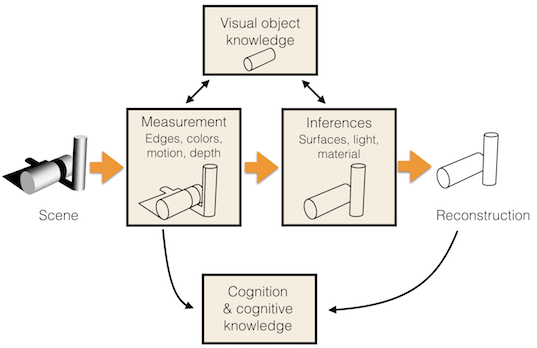Vision: How does it work?

Visual processing begins with measurements of local features like orientation and color, followed by an inference stage that makes the best story to explain these measurements. The output of the inference stage is a reconstruction of the scene populated by recognized objects, surfaces, light, and shadow. Cognition may reason about information at the measurement or reconstruction stages based on an independent database of object knowledge but if it disagrees with the percept, it can rarely influence it and simply notes the discrepancy as an illusion. Much of our research uses these discrepancies between the percept and the reality to understand visual processing, and in particular, inference processes.
RECENT BOOK !!

How the perception of shadows, studied by vision scientists and visual artists, reveals the inner workings of the visual system.
From Amazon: click here
From MIT Press: click here
Reviews
"Casati and Cavanagh have done an invaluable job in bringing to the fore an underappreciated feature of our visual world. This is compulsory reading for anyone interested in the importance of nonuniform illumination in perception, cognition, and art." PDF
―Frederick A. A. Kingdom, Department of Ophthalmology, McGill University.
“I love this book. Not since Leonardo has anyone so carefully and accurately described the, surprisingly to me, many properties of shadows. After reading it, I find myself observing shadows as I never did before, especially the astigmatic shadows of elongated fluorescent lights.”
―Margaret S. Livingstone, Takeda Professor of Neurobiology, Harvard Medical School
“The word 'shadow' is a familiar linguistic term: 'She worked for a shadow agency,' 'She emerged from the shadows,' 'He is a shadow of his former self, and 'the shadow of war,' to name a few. As these phrases suggest, shadows can be somewhat mysterious. Casati and Cavanagh's beautifully written and beautifully illustrated book elucidates the nature, importance, and beauty of shadows.”
―Hany Farid, Professor, School of Information, University of California, Berkeley
“Beyond a shadow of doubt―this book is destined to become a classic. We usually regard shadows as a device for accentuating the artistic appeal of pictures, not as a subject worthy of scientific study. Casati and Cavanagh dispel this view using cleverly designed experiments to illuminate the science underlying the world of shadows.”
―V. S. Ramachandran, Distinguished Professor, University of California, San Diego; author of The Tell-Tale Brain
“This book is a wonderful journey in the world of light and shadows. It is an authoritative essay by two of the scientists who have made the greatest discoveries on shadows in recent times. The book is flush with basic principles, some natural, others counterintuitive, always richly illustrated. It will interest not just scholars who work on shadows, but anyone interested in optics, human perception, and the visual arts. Read this book and you will share the excitement of artists and scientists who have been bewildered by the number, complexity, and beauty of all the shadows around them.”
―Pascal Mamassian, Directeur, Laboratoire des Systèmes Perceptifs, École Normale Supérieure, Paris
“Vision science can inspire artists and art can inspire vision scientists, and this interplay has flourished in recent years. Now, in one of the finest examples of this new synergy, Casati and Cavanagh have mined a rich vein, using shadows to illuminate both vision and art. In lively language, the authors present the fundamental paradox of shadows: how crucial they are to the construction of our perceived world and yet how unnoticed and unremarked their existence. The many fascinating photos and gorgeous paintings enrich this lively romp through the world of shadows.”
―Alan Gilchrist, Professor, Department of Psychology, Rutgers University